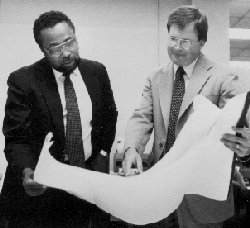Early in 1984, while the Strategic Planning and Finance Committee was beginning its studies, MSD pushed vital projects ahead.
First, MSD and the Environmental Protection Agency reached an agreement on the long-delayed West County sewer expansion program. The proposed treatment plant’s capacity would be reduced to 15 million gallons per day — one-third the originally proposed capacity. The initial emphasis would be placed on serving the Pond Creek area, where small plants and septic tanks had polluted the streams so badly that plans for a recreational lake had been delayed indefinitely. New sewers would not be mandated in the southwestern neighborhoods served by septic tanks (the Dixie Highway corridor).
At the same time, the agency and the EPA agreed that the North County plan was out of date, and work on its revision began.
Next, MSD and the EPA agreed on a $12.5 million program to upgrade the Morris Forman plant to meet federal water pollution standards; EPA agreed to pay 75 percent of the cost.
A New Director; A New Direction
In mid-1983, MSD had hired an executive search firm to seek and screen candidates for the executive director’s position. After months of work, a field of well over a hundred candidates was narrowed down to three strong finalists — none of whom had applied for the job.
On May 1, 1984 — exactly a year after the flooding that precipitated MSD’s management crisis — Gordon R. Garner became MSD’s new executive director. He came to Louisville from Lexington, where he had run the city-county public works department since 1975.
Less than three months after he took office, Garner submitted an annual report that would dramatically change the agency’s view of its mission. "If something contributes to the health of the citizens and environmental quality, be it improving or preserving water quality, MSD is for it," he wrote. "If something detracts from the environment by lessening water quality, MSD is against it."
In the years to come, MSD would seek ways in which it could expand its services to the community — instead of seeking ways to avoid responsibility, as it had seemed to do in the drainage controversy with the City of Louisville.
Gordon R. Garner: An 'Avowed Environmentalist'
At age 37, Gordon R. Garner became the youngest man ever to head MSD — and the first to call himself an "avowed environmentalist."

Elaborating on this in 1984, he told Courier-Journal reporter Larry Tye:
"I believe that present and future generations have both a right and an obligation to clean air, clean water and protection from hazardous materials in the environment."
"There are very few activities we do as people that do not have some negative consequences in those areas. As we go about doing things, we must always keep in mind the environmental consequences and move towards minimizing those impacts."
That philosophy, enthusiastically supported by the board, would broaden MSD’s view of its mission tremendously in the next few years.
Garner came to Louisville from Lexington, where he had served for nine years as the first public works commissioner in the Lexington-Fayette County urban government. There, he had been in charge of the countywide sewer expansion program, along with programs in garbage collection, streets, traffic engineering, public property and building maintenance.
A native of Northern Kentucky, Garner earned his bachelor’s and master’s degrees in engineering from the University of Kentucky. He installed drinking water and sewer systems on Indian reservations in Arizona, and served as city engineer in Hampton, Va., before going to Lexington.
Attacking MSD’s problems as soon as he arrived, Garner said the top priorities included repairing the Morris Forman plant, building the proposed West County plant, extending sanitary sewer service throughout the county, and finding a countywide solution to storm drainage problems.
Garner emphasized in several early interviews that major changes had started at MSD before he arrived, and he complimented the professionalism and responsiveness of the staff he inherited. One of his greatest challenges, he said, was to promote creative thinking and a customer service ethic — an ongoing effort that would continue through the rest of MSD’s first half-century.

MSD Photo by Martin E. Biemer
Movement Accelerates
Construction of the new West County plant began in the fall of 1984. It would be completed in just over two years — four months ahead of schedule — and within its original budget of $22 million.
While construction got under way, state and federal regulators were increasing the pressure on the small plants in the Pond Creek area. The EPA gave the Okolona system a choice: spend $3.75 million to upgrade its plant, or join the MSD West County plan. That summer, the Okolona system agreed to an MSD takeover, which took effect in January, 1985. The wastewater was pumped to the Morris Forman plant until the West County plant was completed.
In late 1984, MSD outlined its plans to take over and eliminate small treatment plants. Shortly afterward, the county health department released a study showing that all major streams in Jefferson County were unsafe for swimming; it blamed small treatment plants and septic tank systems. The state gave the owners of 14 small plants in the West County area until April, 1985 to shut down; at least half were violating their permits, and some had never bothered to obtain permits — a clear violation of state and federal environmental laws.
MSD History continued - Industrial Waste and Hazardous Spills


